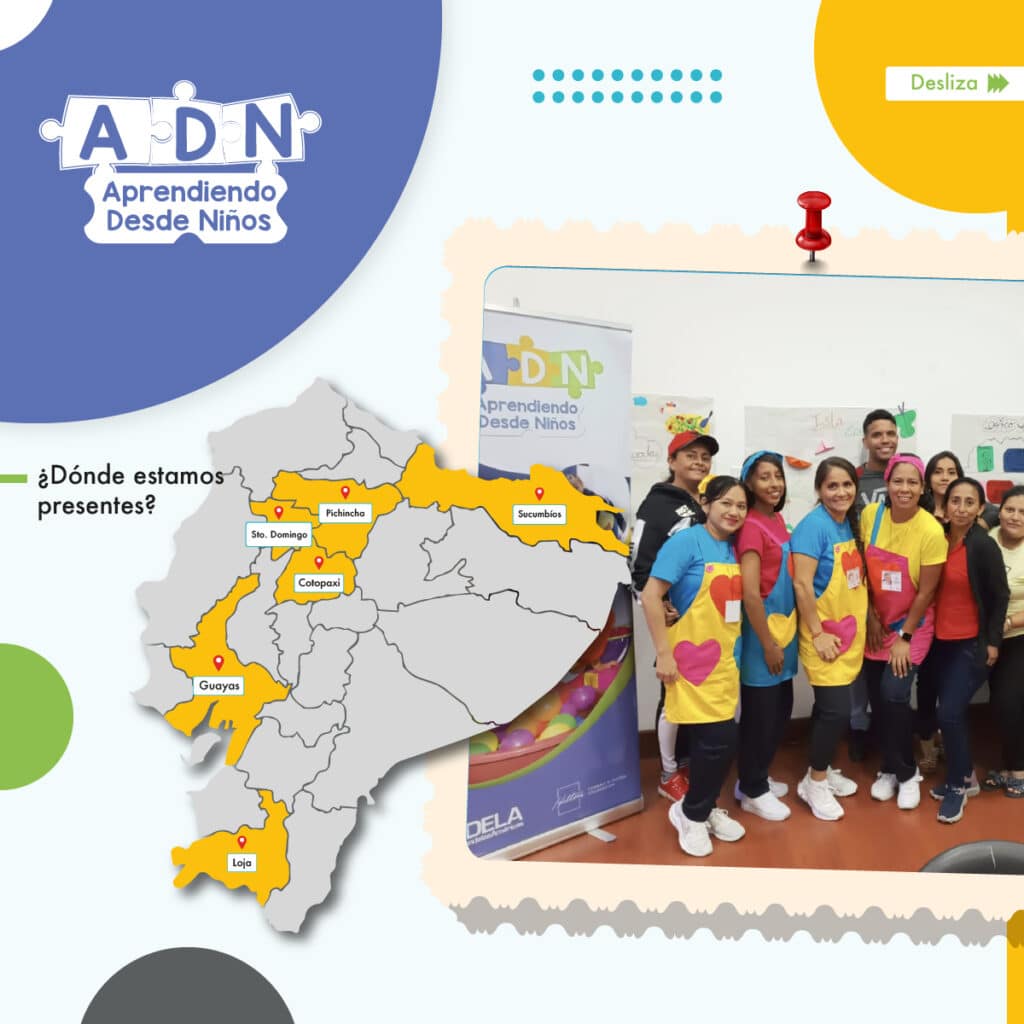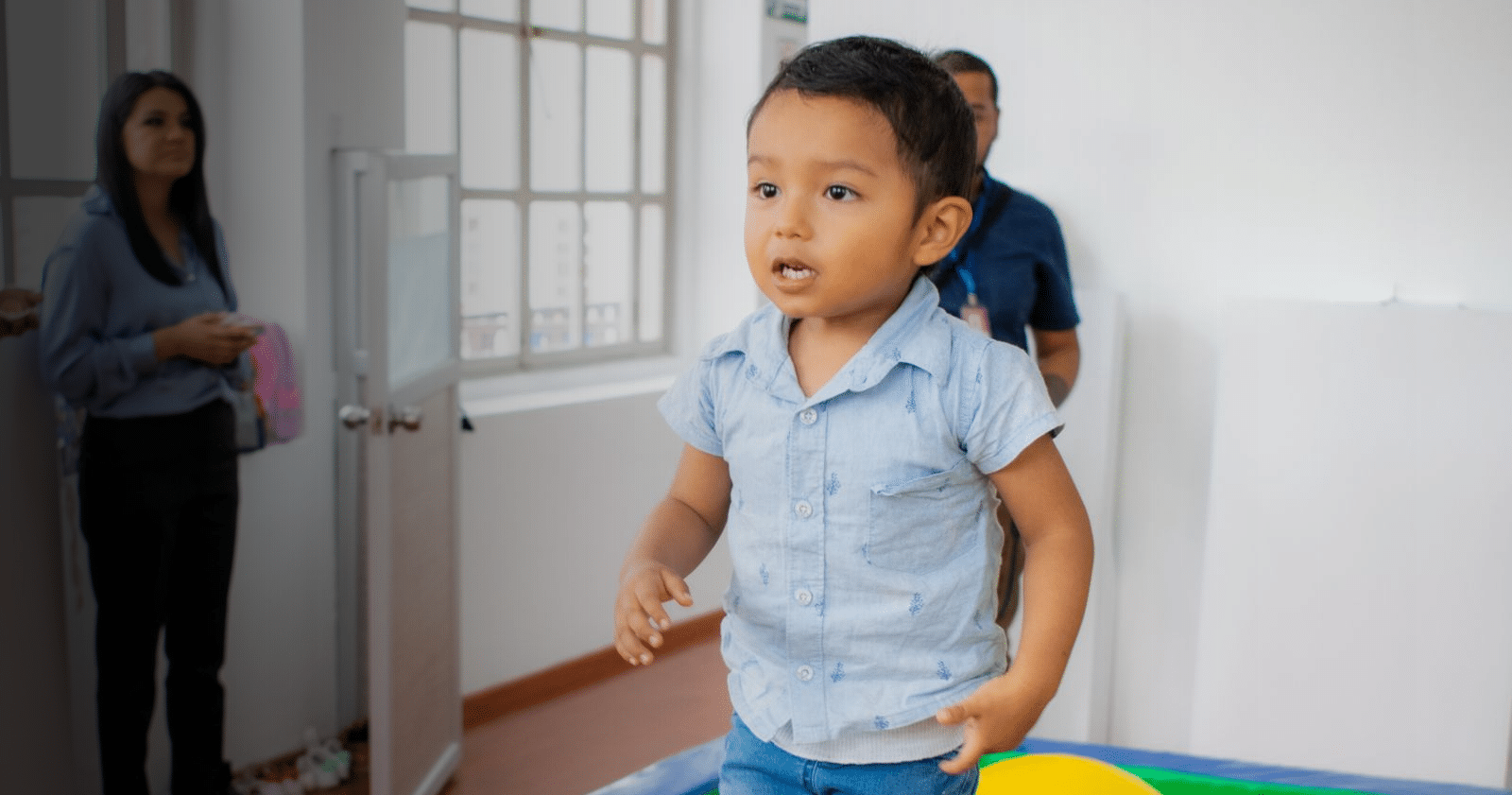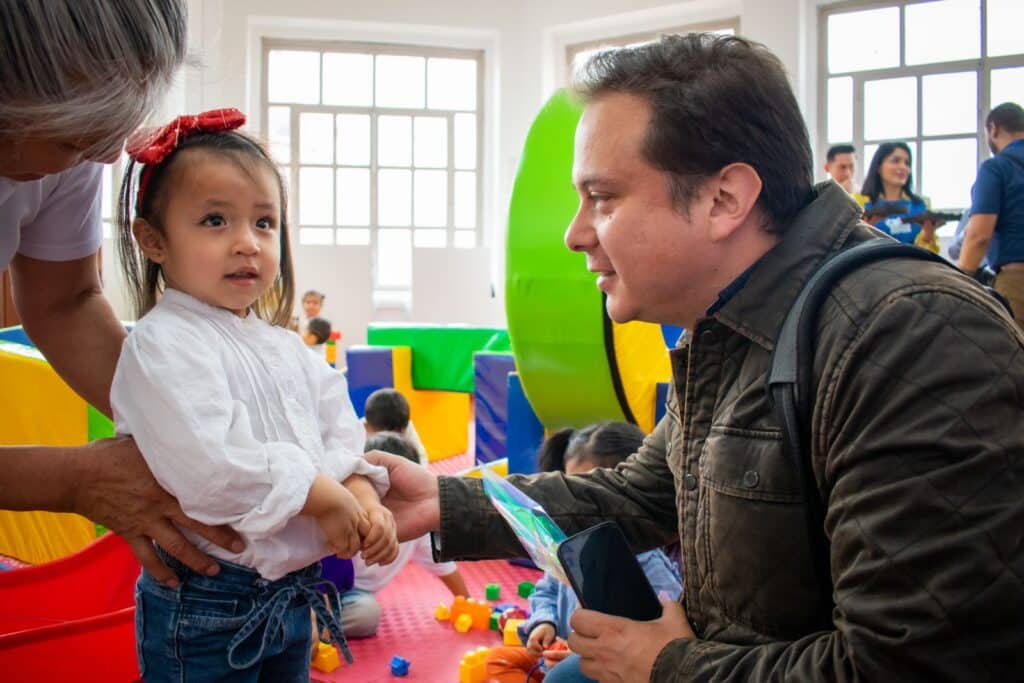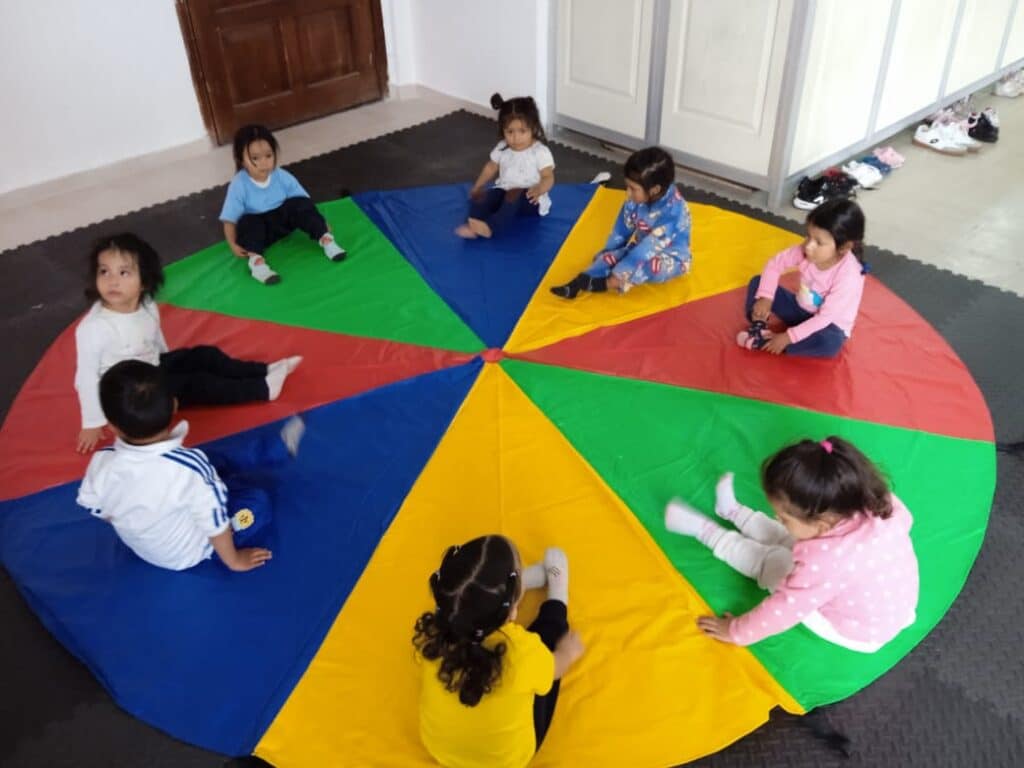Technical assistance to Fundación de las Américas (FUDELA)
General Info
Supported entity and its role in implementing the program:
-
Instiglio provided technical assistance to design a results-based financing (RBF) mechanism for a childcare center program for FUDELA.
Program:
-
Aprendiendo Desde Niños – (Learning since Children)
Program Funder:
-
Conrad N. Hilton Foundation
Sector:
-
Early Childhood Development
The entity’s point of contact:
-
Martha Miranda. Email: mmiranda@fudela.org.ec
-
Paulo Gutierrez. Email: pgutierrez@fudela.org.ec.
Instiglio’s point of contact:
-
Santiago Ospina – santiago.ospina@instiglio.org
Type of support provided by Instiglio:
-
RBF mechanism design
Executive Summary
Between 2020 and 2023, Ecuador experienced a surge in immigration, positioning itself as a crucial transit point for migrants and displaced population, particularly from South America. During this time, approximately 871,000 immigrants, 40% of whom were children and adolescents, sought refuge in Ecuador1. Migrants and displaced population face challenges, such as limited access to food, shelter and undocumented status in Ecuador. Relative to other populations, challenges like these are often exacerbated given the populations’ high degree of mobility. Children aged 0 to 5 encounter especially tough circumstances, as these adverse conditions hinder cognitive, social, and emotional development, essential for early learning and development during these crucial early years.
Fundación de las Américas para el Desarrollo (FUDELA) is a non-profit organization that focuses on human protection, livelihoods, and local capacity building. Building on their commitment to helping vulnerable populations, FUDELA launched the “Aprendiendo Desde Niños” (ADN) program, a franchise network of childcare centers (ADN Centers) using a child development model across multiple provinces in Ecuador. The program, funded by the Conrad N. Hilton Foundation, addresses the developmental needs of children in vulnerable conditions.
FUDELA aimed to catalyze the cost-effectiveness of its program while ensuring its sustainability. To achieve this, it partnered with Instiglio to transform the intervention’s effectiveness and focus on enhancing its results. A preliminary diagnosis of the ADN program identified potential challenges, including limited capacities in ADN Centers, constrained resources, and high mobility of migrants and displaced population. FUDELA and Instiglio explored the utility of an RBF mechanism to help the ADN program overcome challenges that limited program performance and future scalability. FUDELA and Instiglio found that RBF could be useful in this case as it could incentivize childcare centers to strengthen their internal capabilities, prioritize quality service delivery, adapt their services to the specific needs of the population attended, attract additional funding and enhance accountability. This shift, promoting both effectiveness and financial sustainability, offered a promising path for long-term impact on ADN Centers.
Four ADN Centers were selected for an RBF pilot following a capacity assessment. Payment metrics were designed to promote key impact dimensions, including:
1. Capacity amplification. Incentivizing increasing the number of children attending centers and opening additional vacancies for displaced children.
2. Improved content and childcare practices. Incentivizing implementation of the Montessori early stimulation model, an educational approach emphasizing self-directed learning and hands-on activities for young children.
3. Enhanced economic sustainability. Incentivizing future sustainability via improved income generation capacity of the Center.
The program preparation began in early 2023, and implementation commenced in January 2024 with a budget of approximately USD 2 million. It is scheduled to conclude in November 2024. FUDELA will assess the impact of introducing these three incentives to promote improved service delivery and sustainable growth. If the RBF model is successful, FUDELA may scale up the RBF model across all ADN Centers, contributing to overall program scalability.
Project
Partners


What was the opportunity?
For over a decade, Ecuador has emerged as a pivotal hub for migrants and displaced populations, particularly within the South American region, serving as a crucial transit point north to the United States. Situated along a major migratory route, Ecuador finds itself linked to the evolving patterns of mobility in the region. Between 2020 and 2023, Ecuador -home to approximately 17 million people- welcomed over 871,000 immigrants2, of which 40% were children and adolescents3 aged 0 to 17. According to surveys with migrants, 67% face inadequate access to food. Despite the government’s ongoing efforts, a significant number of migrants and displaced people are undocumented in Ecuador, impeding their access to formal employment. Such challenging socioeconomic circumstances significantly impact the cognitive, social, and emotional development of migrant and displaced children aged 0 to 5, highlighting the critical importance of addressing their needs during these early formative years.
To improve the situation facing vulnerable youth in Ecuador, FUDELA has undertaken initiatives aimed at holistic human development. FUDELA focuses on three strategic pillars: human protection, livelihoods, and generating local capacities. FUDELA works across nine provinces nationwide, and one key intervention the organization employs is the “Aprendiendo Desde Niños” (ADN) program. This initiative seeks to establish a child development franchise model for childcare centers in both urban and rural areas across Ecuador, including in the provinces of Carchi, Imbabura, Pichincha, Cotopaxi, Loja, Guayas and Santo Domingo de los Tsáchilas. Directed at children aged 0 to 5 in vulnerable conditions, the ADN program aims to empower childcare centers to sustainably expand their services. These ADN Centers are dedicated to ensuring long-term operational quality and promoting the overall wellbeing of children.
Based on FUDELA’s experience so far, implementation challenges may limit future program sustainability and scalability. Key challenges include a lack of capacities, information, and methodologies in ADN Centers to achieve desired results; limited resources to sustainably enhance service provision; and the high mobility of migrant populations, which make it hard for displaced populations to access or receive services. FUDELA desired to address these challenges and explore how to maximize its budget to create the most sustainable and enduring intervention model for the ADN program.
To achieve these goals, FUDELA and Instiglio created a pilot RBF mechanism that creates financial incentives within the contracts with ADN Centers. The incentives use a results-based approach meant to foster improved results in the pursuit of FUDELA’s ADN program mission.
What was our response and what was it about?
The challenges FUDELA faced with its ADN program are common among nonprofit organizations and government entities. Instiglio, with the support of the Conrad N. Hilton Foundation, supported both FUDELA and the ADN Centers to identify how a RBF could support them in enhancing their impact and sustaining the ADN program in time. This approach is useful to shift FUDELA’s focus to measurable program results, provides flexibility to ADN Centers to achieve results, better aligns incentives with the wellbeing of the children served, and enhances program accountability and learning systems. Collectively, this initiative aims to create incentives for ADN Centers to be more results-oriented and become self-sustainable.
Instiglio’s work with FUDELA and the ADN Centers to design the RBF mechanism took place in three phases:
First, Instiglio collaborated with FUDELA to develop the theory of change and formulate the implementation plan for the RBF mechanism. The theory of change identified the key outcomes and impact intended by the program, and through an assessment of FUDELA’s current performance, it pinpointed the outcomes to be strengthened through the RBF mechanism. These outcomes include an increase in enrollment, fulfillment of technical requirements and quality standards by teachers and assistants, including the effective implementation of the Montessori early stimulation model4, and the continuous implementation of initiatives by the center to maintain additional vacancies.
Second, Instiglio supported FUDELA at selecting a subset of ADN Centers to pilot the results-based program. A first wave of 18 ADN Centers was assessed across criteria, including unresolved economic needs, limitations on growth, and service improvement potential. Ultimately four ADN Centers were selected following interviews conducted by Instiglio to determine their readiness and fit for managing an RBF design. Criteria included long-term impact, financial capacity, performance management, and organizational and legal attributes. The four ADN Centers selected to pilot the RBF design were: i) Centro Nuestros Jóvenes in Quito, Pichincha, ii) Centro del Muchacho Trabajador in Quito, Pichincha, iii) Centro Divino Niño in Guayaquil, Guayas, and iv) Centro Los Sagraditos in Santo Domingo, Santo Domingo de los Tsáchilas.
Third, Instilgio, FUDELA, and the ADN centers designed payment metrics (i.e., financial incentives) to promote greater attention to and performance on the selected areas of focus from the theory of change exercise. The payment metrics define the specific outputs or outcomes to be achieved, which are then rewarded with financial payment to ADN Centers. If the metrics and their pre-defined goals are not met, the financial incentive is not paid. The total budget allocated for the intervention is approximately USD 2 million, with USD 936,000 directly allocated to the 18 ADN Centers, of which approximately 5% is tied to the achievement of the agreed results for the four ADN Centers that are a part of the RBF pilot. Concretely, three payment metrics derived from the established outcomes were set:
1. Sustainable increase in the number of children attended.
2. Implementation of the Montessori early stimulation model by teachers and assistants.
3. Increase in the ADN Center income through secondary sources.
Refining the payment metrics, indicators were defined that detail in more specificity exactly what is to be measured for each payment metric. These include:
1. Number of children that attended each ADN Centers during at least 80% of the program duration, considering the additional vacancies assigned for each Center.
2. Percentage of teachers and assistants successfully implementing the Montessori early stimulation model, based on the total number of teachers and assistants within the program for each Center.
3. Difference in average income from a secondary source during the last three months of the program compared to the one three months before the beginning of the program.
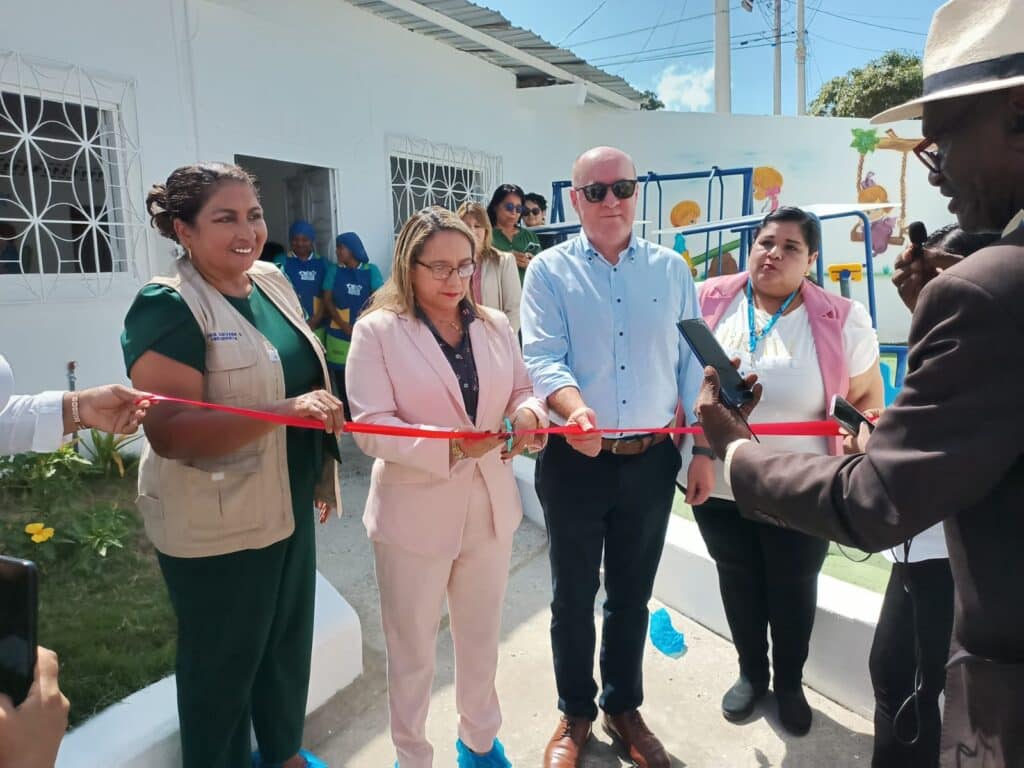
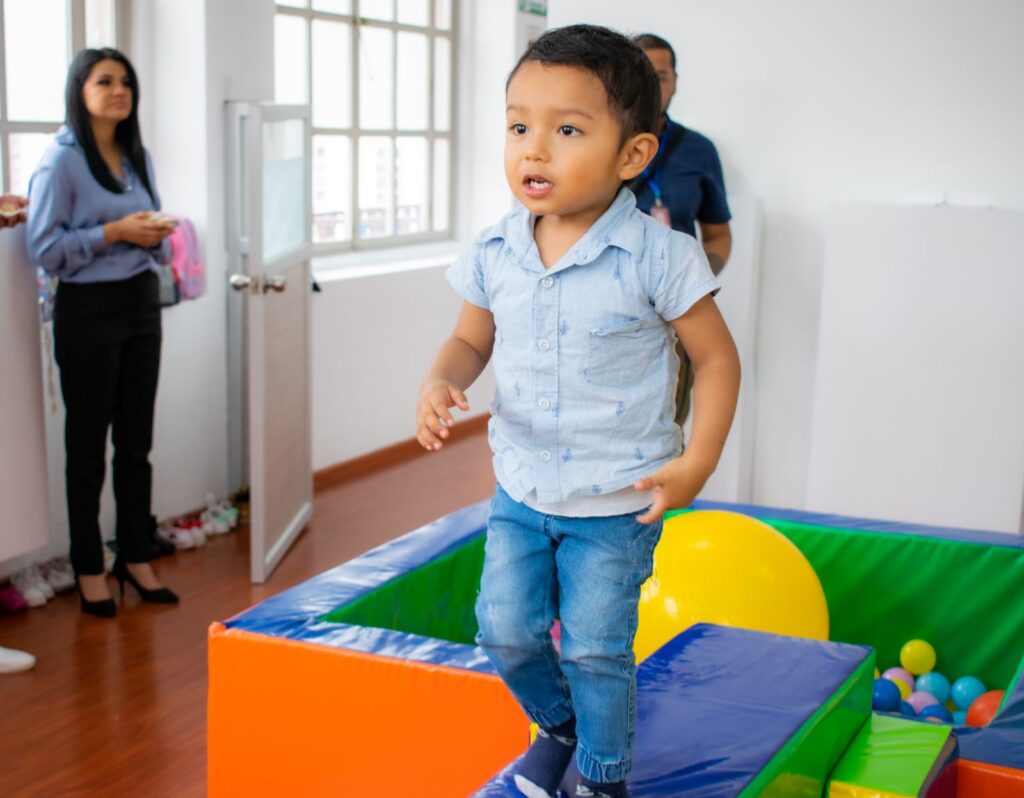
Implementation Phase
In September 2023, FUDELA and ADN Centers incorporated the results-based design into their agreements for ADN program 2024 implementation, which began in January 2024 and will conclude in November 2024. In April, July, August, and September, self-reported data will be submitted to FUDELA for prior verification, to assess if the predetermined targets for the indicators and payment metrics mentioned above have been achieved. If the targets are met, the agreed-upon resources linked to the results will be disbursed in May and October.
In the longer term, FUDELA aims to assess if and how the results-based incentives allowed ADN Centers to improve service delivery, promote more sustainable growth, and/or enhance overall results for children. If successful, this pilot intends to serve as a model to create other results-based designs and incentives across all Centers to further enhance program results into the future.
Lessons Learned
Two key lessons learned have been identified from the RBF design phase of 2023. These may be especially useful for those seeking to use RBF in contexts with multiple implementers and in situations where the social intervention is relatively new.
When multiple implementers (e.g., 18 distinct ADN Centers) are involved with a common end goal, it is crucial to achieve certain standardized capabilities among implementers to initiate an RBF pilot.
Certain levels of specific capacities among implementers are crucial in piloting an RBF mechanism, as they play a key role in achieving the mechanism’s goals. Uneven capabilities among Centers could lead to an imbalance in incentives, resulting in higher costs than benefits. This scenario could occur where the costs for Centers to reach objectives outweigh the gains. During the selection of ADN Centers to participate in the pilot, capacity evaluations were conducted through interviews. It was crucial that all selected centers demonstrated relatively homogeneous expected capacities. This uniformity is essential as the program relies on all centers being impactful to achieve scalability and sustainability. The evaluation criteria for selecting ADN Centers included: i) impact and long-term sustainability, assessing potential for attention and growth ii) financial capacity, evaluating basic capabilities in resource management and reinvestment iii) performance management and information use capacity, essential for transparent monitoring processes during the RBF mechanism iv) organizational and legal capacity, assessing governance order and the presence of legally trained personnel—critical for internally managing the necessary processes to incorporate RBF within contractual frameworks.
When designing a new RBF model for the first time within a specific context, it may be preferable to select payment metrics related to outputs rather than outcomes of the intervention.
In the process of launching an innovative RBF model within a specific context, it is essential to grasp the distinction between outputs and outcomes. Following the logical pathway of the theory of change, outputs act as intermediary achievements leading to outcomes, which ultimately drive impactful changes. Outputs, being more tangible and directly linked to the activities undertaken, offer a simpler pathway for measurement and attribution, thereby granting implementers greater control over the process. Stepping into RBF implementation for the first time inherently involves a learning curve and elevated risks due to the novelty of the approach. Moreover, venturing into RBF with a relatively short program lacking substantial evidence further amplifies these risks. This is because limited prior data makes it challenging to accurately establish baselines, measure impact, and effectively fine-tune the program dynamics for optimal outcomes. To mitigate this risk and set them up for success, it is imperative to tailor the program’s structure to match the organizations’ level of experience and capacity. This ensures that the program design aligns with their capabilities, thereby minimizing potential setbacks, such as the failure to achieve desired results.
This approach finds practical application in the ADN project. For instance, a payment metric such as “teacher implements the Montessori model” represents an output rather than an outcome, such as “child attains the expected level of educational development.” This distinction underscores the program’s emphasis on measurable and attributable outputs, aligning with the needs and capabilities of new implementers.
References
Fundación de las Américas. (2023). Proyectos actuales. Retrieved from https://fudela.org.ec/
Migration Policy Institute. (2023). Ecuador Juggles Rising Emigration and Challenges to Accommodate Arrival of Venezuelans. Retrieved from https://www.migrationpolicy.org/article/ecuador-emigracion-migracion-venezolanos
UNHCR. (2022). An Assessment of Venezuelan Refugees and Migrants in Ecuador Reveals Their Most Critical Needs. Retrieved from https://www.acnur.org/noticias/comunicados-de-prensa/una-evaluacion-personas-refugiadas-y-migrantes-venezolanas-en
